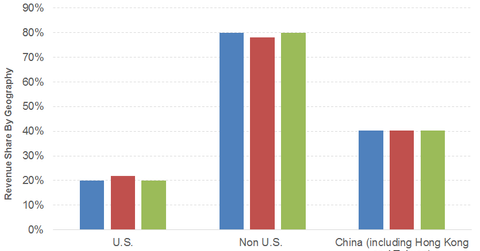Understanding How Intel and China Depend on Each Other
Intel announced $72.0 million in investments in 12 tech startups to drive its AI, cloud, IoT, and silicon technologies.
Aug. 3 2018, Updated 11:40 a.m. ET

How has Intel transformed itself?
Intel (INTC), the leading semiconductor manufacturer, is undergoing a transformation to become a leader in the data-centric, artificial intelligence, and autonomous revolution space. This transformation has been adequately reflected in the revenue growth of the company’s reportable business segments.
Intel’s involvements with China
Intel generated 80.0% of its net revenues from the non-US regions in fiscal 2017. China (including Hong Kong and Taiwan) contributed 40.0% to its net revenues. The company dedicates 20.0% of its revenues to R&D (research and development) and capital spending. Lower tax rates in China have encouraged Intel to revamp its Dalian manufacturing facility.
Lenovo Group Limited (LNVGY) was responsible for 13.0% of Intel’s revenues in both fiscal 2016 and fiscal 2017. Lenovo, Dell (DVMT), and HP Inc. (HPQ) formed 38.0% and 40.0% of Intel’s revenues in fiscal 2016 and fiscal 2017, respectively.
Significant developments between Intel and China in 2018
In January, Intel announced strategic partnerships with China-based automotive manufacturer SAIC Motor and digital mapping company NavInfo. The partnerships plan to develop autonomous vehicles and bring Road Experience Management (or REM) Mapping to China.
Intel announced $72.0 million in investments in 12 tech startups to drive its AI, cloud, IoT, and silicon technologies. Three of the 12 startups are in China—Reconova, an AI company; Alauda, a container-based cloud services provider; and Espressif Systems, a semiconductor company.
On May 10, former Intel CEO Brian Krzanich discussed China’s AI plans sponsored by public-private funding assurances and industry-government alignment. China played a crucial role in the 5G New Radio Global Standard trial. Intel announced an alliance with Unigroup Spreadtrum & RDA on February 22 for the development of a 5G smartphone platform for the China market.
China’s Baidu (BIDU) formed a partnership with Intel in July. The partnership was aimed at the deployment of Intel’s Mobileye’s Responsibility Sensitive Safety (or RSS) model for Baidu’s commercial autonomous car development programs.
